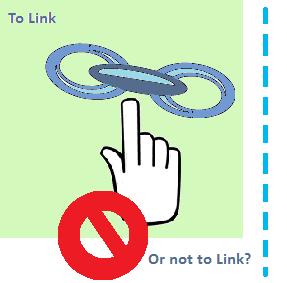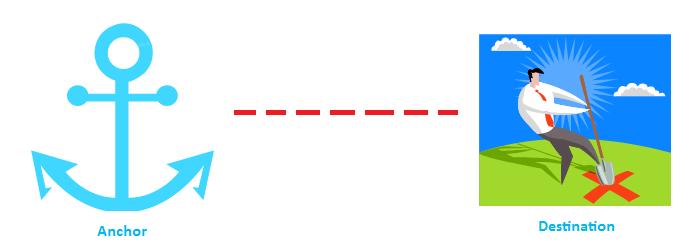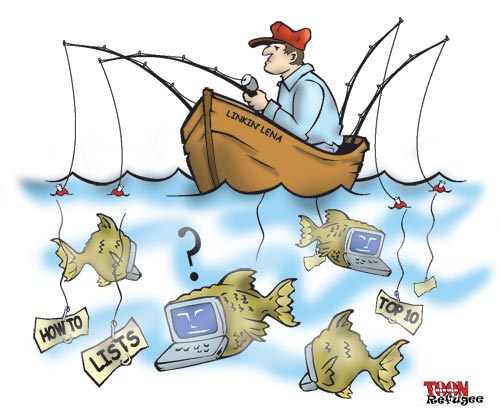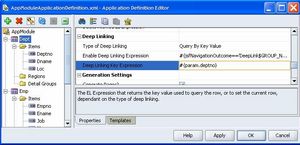To Link, or Not to Link
Contents
Group Name
Fusion
Group Members
Sally Feng, Maryam Abbaszadeh, Claire Geddes- Soltess and Tash Hannan
Initial Project Statement
Technology: Linking between websites
Issue: Linking is the ability to click on some text or image and have it relocate you to another page, area of a page, an email address, a video, an image and more. According to W3C, linking does not indicate:
- an endorsement of the linked page
- an implication that the linked page is created by the author(s) of the page linking it
- consideration of the linked page as part of the originating document
However, there are no 'real laws' regarding the use of linking (ex. no laws to stipulate what kind of linking would be considered copyright infringement). This allows for a variety of legal opinions whenever an issue involving linking is brought up.
Argument
Linking on the Internet makes it easy to connect various sites, documents and other media together. It is this characteristic that truly allows the Internet to become a ‘web’ of interconnecting ideas/ themes. This connection increases the Internet's sense of community and is an easy way for individual's to continually share ideas and concepts across the world. However, there are some concerns over the acceptableness of linking- with the debate of linking as a trademark infringement being a major issue. By exploring the different types of linking, their benefits and disadvantages, the major ethical issues regarding linking and the consequences of linking to untrustworthy or incorrect sites, we will be trying to determine whether or not linking should be promoted or abolished. We will also be presenting various cases in which organizations/ individuals have had linking related problems.
Types of Linking
Types of Links
- Linking to a remote website allows the user to link a page to any other page in the World Wide Web
- Internal linking allows the user to navigate to different areas or sections of the same webpage/ website
- An email link, when opened, will create a new email to a specific address in the default email program of the user
- Targeted links enable the user to jump to a specific part of the webpage, whether it be internal or external
- Linking to an image or video, externally or internally
- Linking to downloadable files
How to Identify a Link
- A link on a webpage usually appears as a different colour from the regular text. When the cursor is on top of a link, it generally changes from a arrow to a hand. However a link can also be shown as a graphic, in which case the user may identify it by clicking on the image
- All the different attributes of the link are written into the HTML. This means that the link destination, link label, link title, link target, and the class of link are all addressed:
In the HTML of the page it would look like this:
<_a href="URL"_title="LINK TITLE"_target="LINK TARGET"_class="CLASS OF LINK">LINK LABEL</a>
Which would show up on the web page like this:
<a href="URL" title="LINK TITLE" target="LINK TARGET" class="CLASS OF LINK">LINK LABEL</a>
The most commonly seen link however simply uses the URL of what you want to link too (the target):
<_a href="http://www.target.web.address.com">LINK</a>
And shows up most like the previous:
<a href="http://wiki.ucalgary.ca">LINK</a>
How a Link Works
A link starts at the source, an anchor, then follows the direction to the destination, which can either be outbound (external) or inbound (internal).
The most common link in the World Wide Web is URL based. The URL may refer to a position in a webpage, a completely different webpage, or a document.
Pros
Hyperlinks are an important part of the creation of the World Wide Web. Tim Berners-Lee saw that hyperlinks were useful in linking information together over the Internet. It is hard to imagine surfing the net without coming across some sort of linking.
- By hyperlinking, users can “jump” from site to site. This is much quicker and more efficient than having to perform a new search for each idea.
- Very useful for showing examples and clarifying a body of text. Instead of quoting long passages, users can link to the site that has the information they require.
- Effective way to show multiple dimensions to a set of information. In hyperlinking, different views are easily presented. As well, hyperlinking can also provide cross references and a dynamic online resource for a set of information.
- Linking increases the usability of a website. It makes it easy to navigate through different pages and also certain words within an article can be linked without disrupting the original content. A great example of this is Wikipedia- while reading an article, users can click on certain words for more information about that particular word and still come back to the original article.
- Search engines are based on linking scores. If many users link to a certain site, then that site has high quality content and will show up quite high in a search engine (high ranking). This makes it easy for other users to locate "best" information.
- Links are trackable. This provides market intelligence for those using a link on their website. This way, users who use links in their websites are able to see their competitors, their consumers and also how they rank on a search engine. By reviewing the website’s traffic logs, it easy to see who has linked to the website.
- Links spice up a page. A site can become more appealing through the use of linking. Embedded links allow users to link audio and video clips. This is more interesting than plain text.
Cons
- Some believe that linking is a trademark ™ infringement that might violate some sacred rights. When one website links to another, there are many concerns regarding the privacy of the information that is being shared. For example, when an individual posts a video on Youtube.com, they are aware that the video can be viewed by everyone. However, the individual only intends for this information to stay on the website they posted it on. When linking occurs, another individual can copy the link of that video and post it on their own website. This may very well invade individual’s privacy if they are not notified of this linking.
- For many website owners, the concern is that they don’t have much control in where their links will be placed. Many companies and businesses who use the internet for marketing and advertising worry that their links will be used in a website that does not quite reflect the message they are trying to portray and may give a misinterpretation of the data.
- Linkers need to keep a constant watch on sites who they have linked to and who have linked to them. This is to ensure that content is up to date and meets the appropriate guideline structure.
- Excessive use of linking is also a problem. There are sites that contain more than 50 links, which generates plenty of traffic and ensures a high ranking on search engines. However, most of these links are not content relevant, which is misguiding for people who are surfing the website. To take action against these types of websites, search engines such as Google bots now ignore most webpages that contain more than 50 links because many are obvious link farms.
- Websites may link with other websites without reading the other website's privacy and copyrighting rules ©. The linker would then be taking a link from a website they do not have permission to link to.
Common Ethical Issues Regarding Linking
- Deep Linking
- Making a hyperlink directly to a specific page or image on another website, instead of the main or home page
- Commercial websites oppose deep linking because:
- Customers bypass advertisements
- Content of webpage could potentially be passed off as work of the linker
- Solutions to prevent deep-linking:
- Writing scripts to redirect users to the main or home page
- Causing the web browser forward and backwards button to operate unexpectedly
- Whenever webpage is refreshed, user is directed to the main page
- Embedded Content Linking (Framing or Iframes)
- Using HTML frames to surround linked content
- Essentially having part of another webpage on your own webpage- a picture within a picture
- Commercial websites oppose this because:
- Users might be lead to believe linked page is part of linker’s site
- Copyright infringement
- To prevent others from initiating a lawsuit:
- Remove link when sites object
- Linking to incorrect, untrustworthy or misleading information/media
- There is no formal organization to police information that appears on the internet
- Anyone can create their own webpage or website
- Webmasters can remain anonymous and therefore might lack responsibility for content and material appearing on their site
- No quality control
- Credibility on the internet could be falsified (Ex. Information or documents found on a webpage may appear authoritative and official. However, the information provided could all be false)
- Solution- having skills to evaluate information found on the internet
- Author
- Is there an author?
- Credentials?
- Contact information? (an organization or phone number, NOT just an email address)
- Publisher
- Evaluating the credentials of entity responsible for maintaining website
- Was the information published in a physical journal/text?
- Examine URL
- Able to determine type of website and where information comes from (domain name)
- .edu - educational institution (ranges from legitimate university research to personal student pages)
- .net - network provider (provides services to subscribing customers)
- .gov - government agency (usually official government information)
- .org - non-profit organization
- .com - commercial business (usually trying to sell or endorse products)
- Is there a way to verify background information or quotes?
- Author
Examples of Linking Disputes
Google and The Church of Scientology
In March 2002, The Church of Scientology sent Google a copyright-infringement complaint which demanded that Google remove a large number of links that connected to various anti-Scientology websites- specifically, for the links connecting to Xenu.net (a site called Clambake, a popular anti-Scientology site). The Church’s complaint involved copyrighted church material that appears on the Internet.
Initially, Google removed the link to Xenu.net, but after various complaints, free speech demonstrations and mass media coverage, the website was once again restored to Google’s search engine. It was again removed after Scientologist lawyers filed a DMCA (Digital Millennium Copyright Act) complaint to Google. This act makes it easier for copyright holders to fight piracy and forced Google to remove the link to Xenu.net quickly or risk being held liable for aiding in copyright infringement.
After this incidence, Google created a new policy in which complaints regarding the removal of links would be forwarded to Chilling Effects Clearinghouse (chillingeffects.org). This organization offers information about Internet rights issues and when a link has been removed from the search result, a small notice at the bottom would direct users to a notice that addresses the reasons for removal.
This example highlights the problem that the law can make organizations liable for linking to sites they do not directly control.[1]
Donkeymania
August of 2003, a judge in Madrid ordered the site DonkeyMania.com to be shut down. DonkeyMania itself did not contain any downloadable files, and contained only links to peer-to-peer (P2P) file sharing networks. Some of these links allowed users to download copyrighted materials.
The creators of the DonkeyMainia.com argued that they did not distribute illegal material, stating that all they did was organize information already on the Internet. They also stated that users should be held liable for how they decided to use the information. In fact, many of the links were shared in online forums.
Javier Maestre, the lawyer for the defense, said:"...It's the first time in Spain that the closing of a web page has been ordered based on the links it contains. It's surprising that they've declared the complete closure of a site for this motive, when the files and linked pages have not been declared illegal."[2]
Olympic Games
In the official Olympic website for Athens 2004, the Hyperlink Policy was that if you wanted to link to their site, a letter of request was required to be sent to the Internet Department. The letter must include:[3]
- a short description of your site
- the ULR of your site
- publishing period (how long you wanted to link for)
- reason for linking
- and finally, in your site, only the term “ATHENS 2004” was allowed to be used
This example shows that the organizers for Olympic 2004 planned ahead to mitigate issues that could arise from linking.
Ticketmaster vs Microsoft and Ticket.com
Later, Ticketmaster filed another complaint against Tickets.com for the same reason. The judge in this case ruled that deep-linking was legal as long as it is made clear who the linked pages belonged to.
Conclusion
Taking into account the advantages and disadvantages to linking between websites, we believe that the concept of linking should be promoted- despite the various ethical issues involved. This is because the World Wide Web is essentially a large community where ideas are shared. Without links to connect various websites with common themes/ideas together, users of the Internet will have difficulty navigating the Internet. Internet searching will become highly inefficient and the elimination of linking will definately decrease the Internet’s sense of community. Without links connecting different sites and materials together, the World Wide Web as we know it today would not exist. In regards to the serious ethical issues involved with linking, the best rule of thumb is to link only to those who have given their permission or clearly state the source/author of the material you are linking to. However, because there are no 'real laws' that govern exactly how linking should be regulated (especially in the widespread and extensive World Wide Web), deciding whether or not to link to a webpage/media file is essentially the decision of the linker.
References
Maryam
- http://hubpages.com/hub/Three-way_Reciprocal_Linking
- http://blogbusinessworld.blogspot.com/2005/02/linking-out-is-seeing-light-for-blogs.html
- http://www.wilsonweb.com/linking/ward-buying-links.htm
- http://www.mediacollege.com/internet/html/frames/pros-cons.html
- http://www.isnare.com/?aid=196812&ca=Internet
- http://www.resources-free.com/article/Building-Link-Popularity-With-Inbound-Links-Reciprocal-Links/50940/
- http://www.netscientia.com/search_engine_placement.html
- http://www.eureka-java-gold.com/tutorials/eb_Legalities_Linking_7258_0_article.html
- http://www.dontlink.com/
- http://www.urbanologyblog.com/?m=200610
Sally
- http://www.mandala-designs.com/marylhurst/day_spa/hyperlinking.htm
- http://www.webproguide.com/articles/Web-Legalities-Linking/
- http://webdesign.about.com/od/legal/a/aa030507.htm
- http://www.bitlaw.com/internet/webpage.html
- http://www.linksandlaw.com/linkingcases-deeplinks.htm
- http://xenu.net
- http://www.brokenkode.com/archives/london-2012-bad-design/
- http://bullpup.lib.unca.edu/library/lr/evalweb.html
- http://en.wikipedia.org/wiki/Deep_linking
- http://www.w3.org/TR/html401/present/frames.html#h-16.1
- http://www.chillingeffects.org
Claire
- http://www.plus2net.com/html_tutorial/html_hyprlnktyps.php
- http://en.wikipedia.org/wiki/Hyperlink
- http://www.ed.uiuc.edu/courses/ci235/tutorial/composer/nc4_link.html
- http://www.answers.com/topic/hyperlink?cat=technology
- http://www.ned.com/group/help/ws/Hyperlinks/
- http://www.webopedia.com/TERM/H/hyperlink.html
- http://www.ddj.com/184413519
- http://smallbusiness.ninemsn.com.au/article.aspx?id=95671
- http://www.dlib.org/dlib/april98/04orourke.html
- http://www.templetons.com/brad/linkright.html
Tash
- http://www.cs.nott.ac.uk/~hla/HTF/HTFII/Selvin.html
- http://google.about.com/od/searchengineoptimization/qt/hyperlinkqt.htm
- http://www.webcredible.co.uk/user-friendly-resources/web-credibility/linking-out.shtml
- http://www.patentperfect.com/hyper.htm
- http://www.mandala-designs.com/marylhurst/day_spa/hyperlinking.htm
- http://www.htmlclinic.com/linking.php
- http://www.promotionworld.com/traffic/article/linkinglegalities.html
- http://www.suestudios.com/articles/article9.htm
- http://www.strongestlinks.com/articles/worthtime.php
- http://www.patentperfect.com/hyper.htm











